The stench of rotting corpses
by rahnuma ahmed
It’s past midnight now, I took a shower after returning home but it refuses to go away.
I can smell it on my wet hair as strands blow over my face while the fan whirs above. I can smell it on my nightwear and, as I rest my chin on my clasped hands, I can smell the stench of rotting corpses and bloated bodies which stretches from Rana Plaza to Adhar Chandra school grounds in Savar ? rise up from my fingers.
It has not only come home with me, all that scrubbing as I showered has proven to be of little use.
It is not the dead workers who are to be blamed. The stench rises from, as Vijay Prasad puts it, the terror of capitalism.
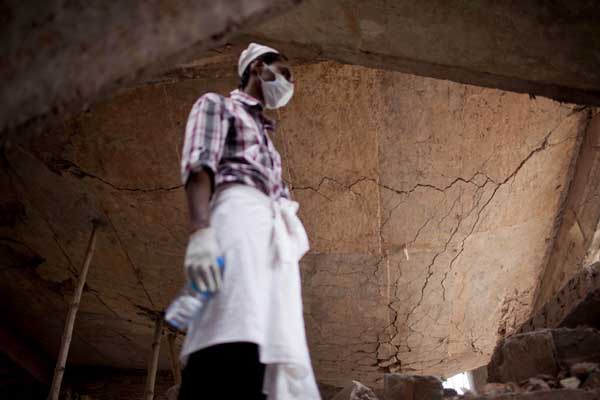
At this end of the subcontracting regime, terror has become normalised, which is why the BGMEA head Shafiul Islam Mohiuddin could get away by declaring in June, there is ?no logic for increasing the wages of workers.?
Which is why the BGMEA could callously disregard the Tazreen factory fire last November ?when more than 112 workers were burnt alive because the gates had been locked. Which is why it could get away by not taking any visible and effective followup measures ? of investigating and identifying structurally unsafe factories, of insisting that they be closed down until safety standards had been met, or else, BGMEA membership would be cancelled.
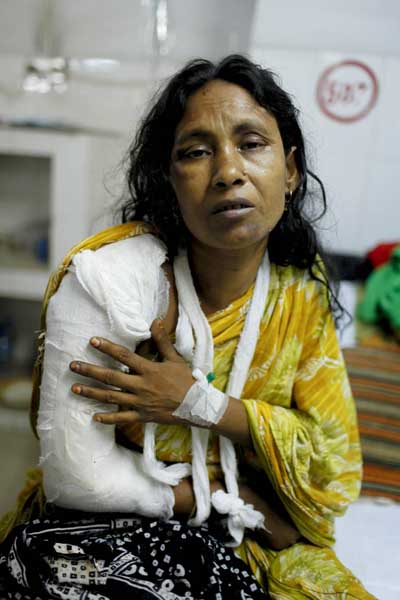
But why should BGMEA members be bothered? As a discussant pointed out in a TV talk show, each BGMEA member chips in only 2,000 taka for a death compensation claim. A pittance when compared to the material benefits owners gain from ?shortening the extent of the labourer?s life? (Marx, quoted by Prasad). Shortening, literally.
Ayon, a photography student of Pathshala, remarked on entering the car as we left Savar for Dhaka, ?Both Lima apu and you smell of corpses. My family members said the same thing when I got home last night, I couldn’t smell it on me but I can smell it on you.?
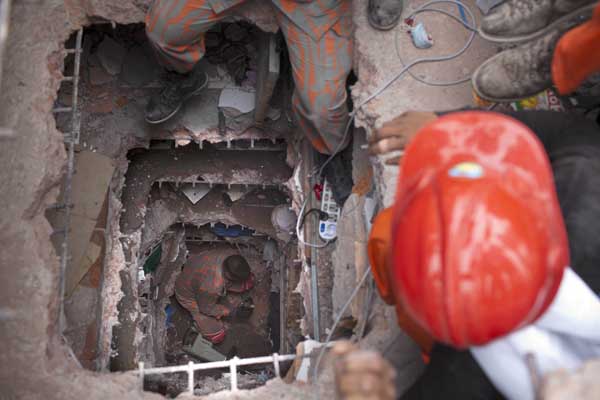
It was Day-3 (April 26), but my first day at Savar.
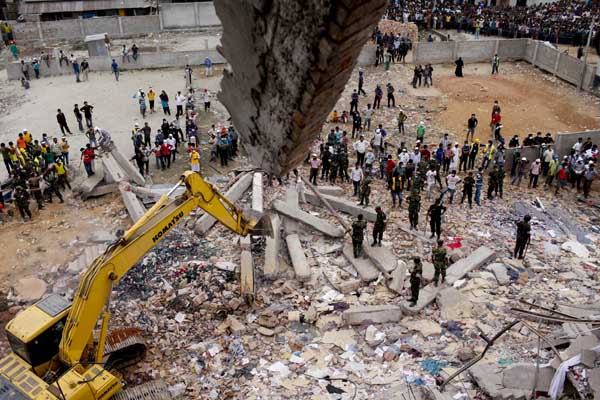
I went to Savar with Lima (short for Taslima, photographer) and her comrades, other activists belonging to Gono Shonghoti, and its student?s wing Chatra Federation, Haroon bhai, Ferdous, Ruzel, and the singer Amal Akash.
Violent worker protests had been raging in areas of Dhaka city, Mirpur, Mouchak, Karwan Bazar (near the BGMEA Bhaban) since morning (Friday), and I hadn?t been certain whether we would be able to leave by car.
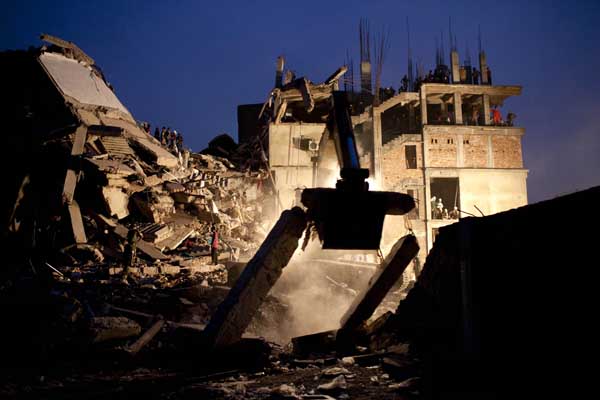
As we approached Savar, I watched streams of people, mostly men, walk towards Rana Plaza. Police cordons, recently effected, meant that we had to leave the car and cross??barriers, which was possible only because of our press cards. Hundreds lining the roads, watched us as we turned into the lane to our left, instead of walking further on to Rana Plaza, located beside the main road, most of it fallen, in ruins. The lane was muddy, we were stopped at the entrance, rescue workers and policemen were on alert, a survivor was being brought out. A flashing glimpse as young men ran down the lane with a young woman on a stretcher, a printed sari, covered in dust, a saline drip.
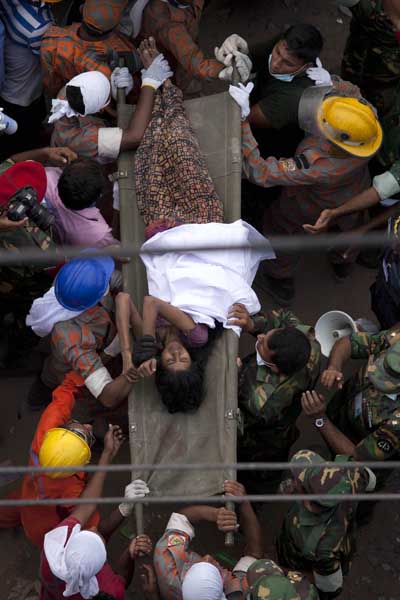
We entered what had been a building yard, now teeming with rescue workers, medics, volunteers, cartons of bottled water, boxes of medicine, a father and daughter handing out surgical masks, all atop rubbles, piles of debris and patches of flatland. I turned??around, looked up and the ghastly sight of Rana Plaza, its floors pancaked, met my eyes.
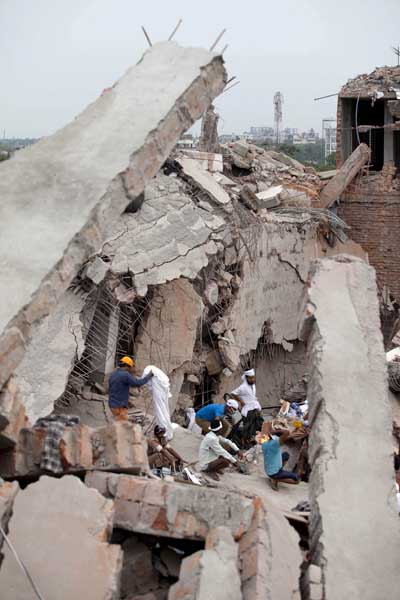
The building had partially collapsed on a neigbouring building which was under construction, we left the yard and entered this building, named RF Towers. Rescue work, we were told, was being conducted on the second floor, we carefully climbed up the cement stairs, no hand railings yet.??A huge cavernous room, you could tell that construction had been ongoing until the disaster had occurred, a narrow strip of luxury tiles on the cement floor was an indicator, iron grills had been put in the large windows but they were shutterless, no frames, no glass. At the far end of the room, if you peered outside the window, you could look into the yard which we had walked into, and if you looked up you could see a section of the pancaked plaza from a greater height.
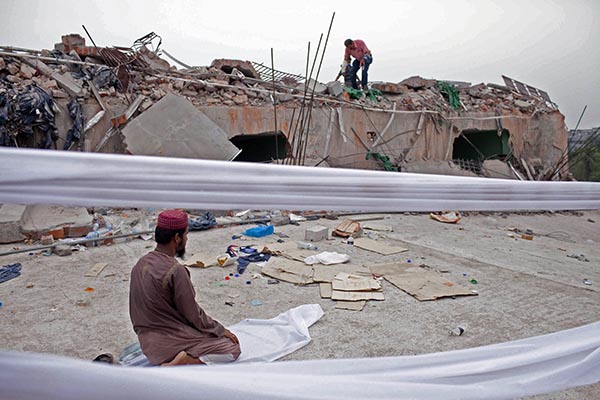
Large sections of the floor were littered with debris ? bricks, slabs, spools of cloth on long cylinders, empty water bottles, scraps of paper, a broken chair, a workman?s iron stool, layers of dust and dirt all around. We walked up to the group of rescue workers, all civilians, all volunteers, young men, mostly in their twenties, gathered together at the short end of the room. A pancaked section of Rana Plaza had jutted into RF Tower ? their sixth floor, into the Tower?s second floor ? the two walls seem to have meshed into one, metal rods spiked out, and in all the concrete, almost a part of it, lay an overturned body, we could only see a section of his head and an outstretched forearm. Dark and mottled, the stench of rotting flesh made `bearable? for rescue workers by frequent sprayings of aerosol, creating a sick, sweet smell which hung over the vast cavernous room, and wafted out its open, shutterless windows.
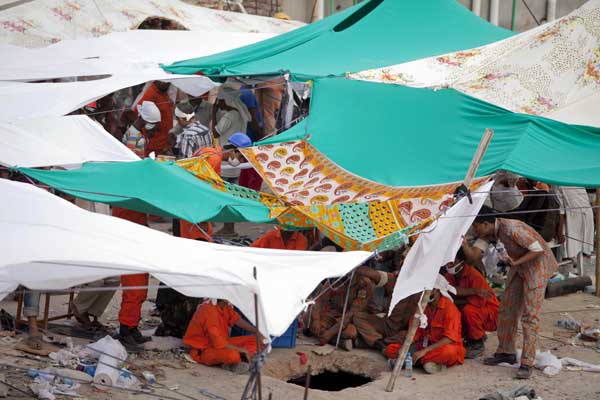
The group began working, they took turns at a pickaxe with a long handle, they chipped away, they cut the metal rods by means of an electric drill, hoping to loosen the concrete, bricks and slabs and pry away the body.
I too worked. Outwardly, I watched, observed, scribbled notes on a small notepad. Inwardly, I saluted the volunteers for their humanity and courage. I cried as well. Who was he? Where was his family? Did he have a wife? What were his dreams? Was death quick and sudden, or was it long drawn out and wretchingly painful? Forgive me, forgive us, I intoned.
I was too engrossed to keep track of time, noticing in snatches only that the strong??afternoon light had given way to evening shadows, later still, to nightfall, as the men chipped away gently, carefully, patiently. I hadn?t known that such instruments of force, pickaxes, shovels, spades, could be used so tenderly, so lovingly; extra hours of work were put in so that the corpse would not be hurt.
Brief visits by two army personnel, comparatively longer vists by two firefighters, but most of the drudging hard work was done by volunteers, who remained singleminded and undistracted, also, pleasantly deferential towards those uniformed, when they did turn up. It was one of the biggest shocks for me, since TV coverage over the last two days had depicted otherwise.
I did come across teeming scores of army personnel later however, busily preoccupied in rescue operations at the front of Rana Plaza, where 12-13 survivors had reportedly been discovered. Incidentally, the floodlights were there, the TV cameras were rolling.
It was dark where we were, rescue work was conducted by handheld torches, and the flash torchlights of mobile sets. When the body was finally pried loose, out popped a mobile set and a national ID card. His name was Halim.
The building had collapsed in two minutes flat, had he, in that brief span of time, tried to contact his family members? To scream, save me, please.
I will never know. I will remain haunted instead, by questions to which I can never know answers to, and by the aerosol-laced sickeningly sweet stench of rotting corpses.
Hello, are you looking for the person who this mobile belonged to? Come to Rana Plaza.
We waited, and a stream of people gradually climbed up the stairs, one after the other. The first man, middle-aged, said yes, it was his nephew, but this was the younger one, the elder too had gone missing, they?d both worked here. Halim?s youngest brother soon came, a skinny lad in his mid-teens, he wore jeans, was bare-chested, with his T-shirt rolled around his neck like a collar. Two young women came as well, they were neighbours. Much later, a young wisp of a girl in a green shalwar-kameez turned up, apparently she was Halim?s wife. No cries, no wailing, it was all subdued, they seemed dazed by the enormity of events. The tears would come later. The stretcher was lifted to the chant of Ashhadu Allah?, the corpse was carried down the stairs by the light provided by Lima?s handheld torch and Ayon?s flash torch.
Another rescue group, civvies, all volunteers, had chipped away at the wall to the left of where Halim was discovered, a hole large enough for a skinny adolescent to wriggle through was made, two young men, one with his lungi hitched up, the other trousered, entered the tunnel. Yes, there are dead here as well. How many? Five, maybe six. Can you drag them to the mouth of the tunnel? No, they?ve decomposed, the hand or leg will fall off if I tug at it. Oh okay, come back. As the young men re-grouped outside the hole patiently, as one of them picked up the pickaxe and struck, we left.
It was past 10 when we reached Adhar Chandra school, about half a kilometre away from Rana Plaza. The school ground is large, expanses which are no longer to be found in Dhaka city?s schools, not even posh ones. Hundreds of notices on the schoolgate and its walls, so-and-so is missing, we seek information of the person dead or alive, in nearly all cases, there was a photo of the loved one.??I walked around, saw men and women huddled in small groups sitting on the ground, vacant looks, silent prayers. A young girl sat alone forlonly. I wandered around, several policemen seated behind a table formed the Police Control Room; on a school blackboard, the numbers of corpses discovered, and the numbers handed over were constantly being updated. An open stall, with cartons of bread and bottled water, charitable donations for the waiting. On the main road, we had seen?khichuri?being cooked by a local family, for family members of victims and rescue workers.
I finally walked over to the veranda of the school building, at the far end of the field. Body bags were lined up, a pickup was parked near one at the close end, a small group of people milling around, ready to take away the corpse. Let the burial at least be decent, I thought, I prayed. It was Halim, I recognised his brother, his wife, their neighbours. Where? Where is home, I asked. Sherpur. Oh.
I climbed up on the verandah, the body bags were open at the top, leaving the faces of the corpses exposed for identification by family members. I saw two men walk away from the first and as I went and stood by, they called out, is it a man or a woman? Mottled dark, gaping holes for eyes, sorry, no, I said, I can?t tell either.
Not all, though. The next one was obviously a woman, long black hair, flecked with generous scatterings of bleaching powder, streamed down her face. The next too, was a woman, but rigor mortis had set in before she had been retrieved, she lay on the floor with her back arched, a leg raised, bent at the knee, an arm outstretched. Like a sculpture, except that it wasn?t a sculpture, she was someone?s daughter, may be wife, may be a mother. Her features were unrecognisable. Bloated beyond recognition. As I left the school grounds I heard a woman?s voice telling the man who accompanied her,?Laash keu ney na, nibo ki, chenai jaeyna?(No one takes the corpses left, how can they, they are unrecognisable). I also heard slogans of?Laash chai, laash chai, raised by twenty or so young men, marching towards the Police Control Room, and a policemen?s voice over the loudspeaker, entreating, We understand how you feel but please?
Maybe,?they?do. But I don?t think many in the upper reaches of state institutions do, for, as one of the activists who?d been present at the HC hearings on April 25th?told me, when a petitioning lawyer had wanted that BGMEA officials too, to be presented before the court on April 30, one of the judges had curtly, swiftly intervened, Let?s leave the BGMEA out of it.?Bicharpoti tomar bichar chaibe jara kobe jagbe shei jonota? (When will the public awaken to demand the trial of its judges?)
It was past 11pm when we left Rana Plaza, a red poster with Sohel Rana (owner of Rana Plaza), local MP Murad Jang (AL) and the prime minister Sheikh Hasina?s photos cheerily waved us farewell.
In the car, Lima and I spoke softly, family members of three victims, she said, had told her on Day-1 that the factories had been deliberately opened after having been evacuated the previous day, to bring out pro-government processions protesting against the BNP-Jamaat?s 36 hour hartal, an allegation which has been reported in sections of the press. Is it true? Is it in any way related to the home minister?s convoluted statements about the building having collapsed because pro-hartal processionists had shaken it? Who is he covering up for? Himself? Someone higher up?
As the stench of rotting corpses lodged in the crevices of Rana Plaza wafts over the country, it marks out the vast majority ? grieving for brothers and sisters sacrificed at the altar of capital ? from the small minority, who wield political and economic power, and feed off human flesh.
Published in?New Age, Sunday?April 28, 2013
